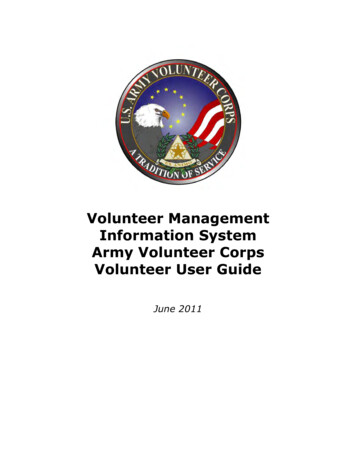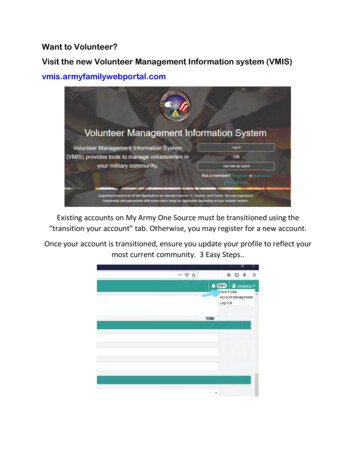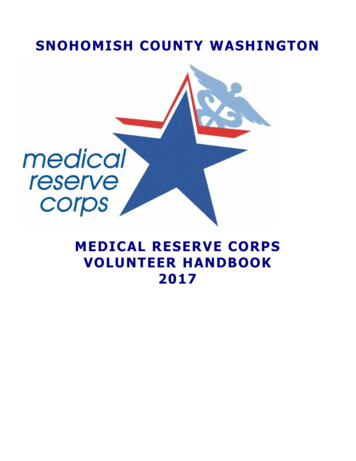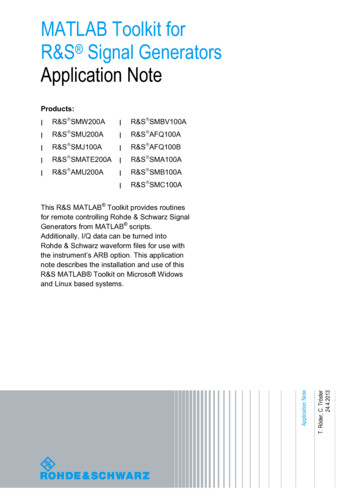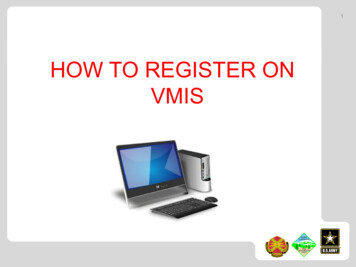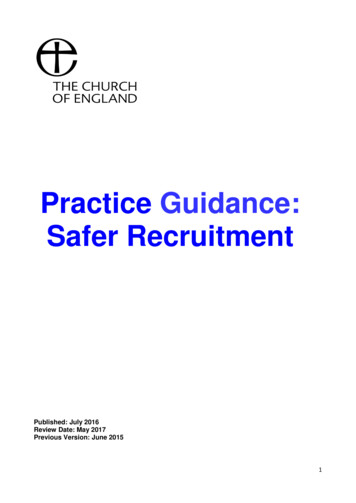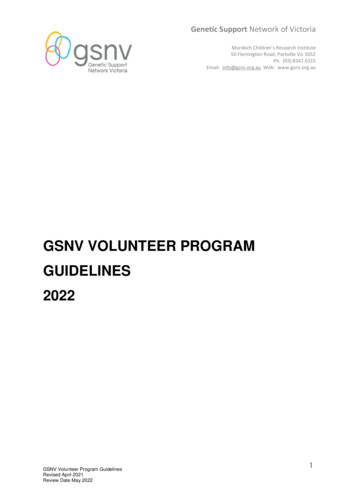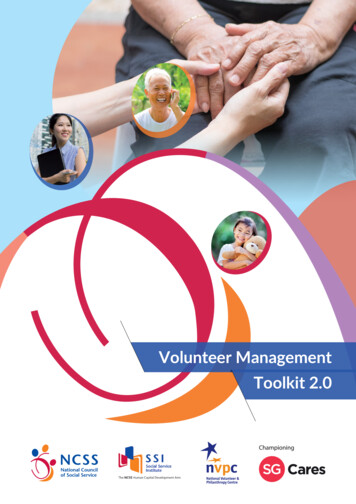
Transcription
Volunteer ManagementToolkit 2.0
VolunteerManagementToolkit 2.0
In This Toolkit.ForewordPart 11IntroductionIntroduction to Volunteerism5Effective Volunteer Management9Volunteer Management Toolkit 2.0Part 2Part 3Conclusion11Implementing the Volunteer Management Framework (VMF)Chapter 1: Getting Your Agency Volunteer-Ready15Chapter 2: Conducting Needs Assessment40Chapter 3: Recruiting and Selecting Volunteers55Chapter 4: On-Boarding and Training Volunteers74Chapter 5: Supporting and Recognising Volunteers84Chapter 6: Reviewing Volunteer Management103Creating A Sustainable Corporate Partnership125138
Foreword 1Foreword byMs Tan Li SanChief Executive OfficerNational Council of Social ServiceThe National Council of Social Service (NCSS)developed the Volunteer Management Toolkitin 2015 to help social service agencies (SSAs)put in place good volunteer managementpractices and identify ways of strengtheningvolunteer partnerships. We are encouragedthat many SSAs have found the tools,templates and case studies useful in theirvolunteer management journey.Recognising the evolving landscape involunteerism and volunteer management,NCSShasenhancedthe VolunteerManagement Toolkit to address some of thesechallenges. A new section with information onhow SSAs can grow and sustain partnershipswith their corporate volunteers has beenincluded to guide them towards sustainedcorporate volunteerism.Over the past 5 years, the volunteerismlandscape has grown rapidly with newchallenges. For example, while advancementsin technology have unlocked numerouspossibilities, better safeguards are needed toprotect against potential breaches in dataprivacy. More SSAs have also developed inmaturity and are now searching for solutionstotacklemorecomplex volunteermanagement challenges and develop newvolunteering opportunities.For many SSAs, the migration to more onlineapplications and recruitment brings about ahigher risk of data breaches. In the enhancedToolkit, we have included a section on bestpractices and guidelines according to the dataprotection law in Singapore to help SSAsmanage data more securely.We would like to express our sincere gratitudeto Lions Befrienders, Rainbow Centre, RSVP,Singapore Red Cross, TOUCH CommunityServices, Trybe, and YMCA who have sharedvaluable feedback that contributed to thedevelopment of this enhanced Toolkit.We hope you will find the enhanced Toolkituseful and wish you continued success in yourvolunteer management journey.
mentToolkitToolkit2.02.0IntroductionIntroductionTo VolunteerTo VolunteerManagementManagementToolkitToolkit2.0 2.0The VolunteerThe VolunteerManagementManagementToolkitToolkit2.0 aims2.0toaimshelptosocialhelp t in putplacein placepracticespracticesto attract,to attract,retain retainand manageand hroughthe provisionthe provisionof practicalof practicaltools toolsand guidelines.and guidelines.This enhancedThis enhancedversionversionincludesincludesnew contentnew contentand elementsand elementsacrossacrossthe Volunteerthe VolunteerManagementManagementFrameworkFrameworkto reflectto reflectthe latestthe latestpracticespracticesas theassectorthe sectorcontinuescontinuesto evolve.to evolve.Also Alsoincludedincludedin this intoolkitthis toolkitis an allis newan allchapternew chapteron “Creatingon “Creatinga Sustainablea rship”.BenefitsBenefitsOf UsingOf UsingThe VolunteerThe VolunteerManagementManagementToolkitToolkit2.0 2.0SSAs wouldSSAs wouldbe betterbe betterable toableidentifyto identifyopportunitiesopportunitiesfor volunteerfor volunteerpartnershippartnershipwithinwithinthe agency.the agency.SSAs wouldSSAs wouldbe betterbe betterequippedequippedwith relevantwith relevantand updatedand updatedmaterialsmaterialsto starttovolunteerstart ldwouldbe betterbe betteralignedalignedin volunteerin volunteermanagementmanagementpracticespracticesfor a greaterfor a greatercollectivecollectiveimpact.impact.1. Getting1. r-Ready3. Recruiting3. Recruitingand Selectingand SelectingVolunteersVolunteers A clear Avolunteerclear volunteervision visionand strategicand strategicplan plan Profile Profileyour agencyyour agencyand volunteersand volunteersto attractto attractwill guidewill yourguideagencyyour agencytowardstowardsbetter betterclarity clarity and selectand selectthe rightthevolunteers.right volunteers.and moreandsuccessfulmore ips. Track yourTrackvolunteeryour volunteernumbersnumbersto assessto assessthe the Put in Putplaceinpoliciesplace policiesfor effectivefor effectiveeffectivenesseffectivenessof recruitmentof agement.management.What typeWhatoftypevolunteersof volunteersare youarelookingyou looking Keep staffKeepengagedstaff engagedand buildandabuild afor? Arefor?thereAre anytherespecificany re.culture.requirements?requirements?2. Conducting2. ConductingNeedsNeedsAssessmentAssessment Define Defineyour agency’syour agency’sneeds needsand identifyand identifyareas areaswhich rt. Identifying Identifyingpotentialpotentialrisks andrisksmitigationand mitigationsteps earlystepswouldearly wouldhelp reducehelp reduceyour agency’syour agency’sliabilities.liabilities.What areWhatyourareagency’syour agency’svolunteeringvolunteeringneeds needsand goals?and goals?How canHowvolunteerscan volunteersplay a playpart atopartsupportto supportthis? this?
WhoWhois thisisToolkitthis Toolkitfor? for?HowHowTo UseToThisUse Toolkit?This Toolkit?If you Ifareyouanareindividualan individualor are or arepart ofparta teamof athatteamhelpsthat withhelps withthe managementthe managementor attractionor attractionof volunteersof volunteersin yourinagency,your agency,this Toolkitthis Toolkitis for you!is for you!This toolkitThis toolkithas beenhasorganisedbeen organisedalong alongthe 6 stagesthe 6 stagesof the ofvolunteerthe his Thisenhancedenhancedversionversionof the oftoolkitthe toolkitwill willalso providealso provideguidanceguidanceon howontohowcreateto createa sustainablea ip.CreatingCreatingA SustainableA p5. Supporting5. Supportingand andRecognisingRecognisingVolunteersVolunteers Providing Providingvolunteersvolunteerswith thewithrelevantthe relevanttools toolsand showingand showingappreciationappreciationwouldwouldhelp helpto engageto engageand retainand retainthem inthemthe inlong-run.the long-run.4. Onboarding4. Onboardingand Trainingand TrainingVolunteersVolunteers Conduct Conductorientationorientationsessionssessionsfor newfor newvolunteersvolunteersfor betterfor betterassimilationassimilationand andenhancementenhancementof theirofonboardingtheir onboardingexperience.experience. Investing Investingin relevantin volunteers’volunteers’skills andskills andcapabilitiescapabilitiesto playtotheirplayrolestheirwell.roles well. Align expectationsAlign expectationsearly earlyfor effectivefor effectivematchingmatchingof needs.of needs. Have regularHave regularand openand opencommunicationcommunicationto identifyto identifywhat whathas beenhasdonebeenwelldoneandwellanyandareasany areasfor improvement.for improvement.What isWhatyourisagency’syour agency’svision visionand purposeand purposefor engagingfor ships?6. Reviewing6. ReviewingVolunteerVolunteerManagementManagement Regular essionshelp develophelp orkingworkingrelationship.relationship. Timely Timelyprogrammeprogrammeevaluationevaluationhelps inhelps inassessingassessingits sustainability.its sustainability.
Introduction
Introduction 5Introduction tovolunteerismWhy do we need volunteers?Volunteers contribute to community development by committing time and effort for the benefit ofsociety. It is undertaken freely and without financial gain.Volunteers play a significant role in community building and bring multiple benefits to agencies,communities and people. Agencies reap enormous contributions of time, talent and skills, andcommunities benefit by being more cohesive through active citizen engagement.Generally, there are three types of volunteerism within the sector.Service-based volunteerismVolunteers support through interaction with service users or directly involved in servicesprovided by the agency (e.g. befriending, therapy escort, exercise facilitator). Commitmentof volunteers is usually on a regular basis.
6 IntroductionSkills-based volunteerismVolunteers support through their talents, experiences and resources to strengthen thecapabilities of the agency (e.g. web designers, photographers, accountants). Commitmentof volunteers is usually on a needs basis.Events-based volunteerismVolunteers support through events or activities (e.g. ushering, fundraising, organisingcamps). Commitment of volunteers is usually on an ad-hoc basis.A volunteer can bring significant contributions to an agency, including:Promoting theinterest andwelfare of SSAsas anambassadorInjectingenergy andenthusiasmComplementingjobs of staffIncreasingengagementwith thecommunityBringing talent,skills andexperience toaugment anagency’sresources
Introduction 7Overview of volunteerism inSingapore and the increasein regular volunteersStats at a Glance201420181 in 6 personsvolunteered1 in 3 personsvolunteered6 in 10 volunteeredoccassionally7 in 10 volunteeredoccassionallyTotal of66 million hoursspent volunteeringTotal of122 million hoursspent volunteeringDespite fluctuations in growth, thevolunteerism rate in Singapore has been onan upward trajectory since 2014.Between 2014 and 2018, the total numberof volunteering hours have almost doubled,with more volunteers exploring informalvolunteering in addition to formalvolunteering channels. While there is aslight dip in average volunteer hours in2016, total number of hours and theoccasional volunteerism had increased.Volunteers play an integral part insupporting our society and social serviceagencies (SSAs). Not only do volunteersprovide an additional source of manpower,but they also enable SSAs to effectivelyreach out and respond to service users.It is therefore important for SSAs to createa positive experience for volunteers byfostering a sense of belonging andrecognising their contributions. In that way,volunteers will be encouraged to continuecontributing towards the respectivemissions and service users of agencies.Source: Individual Giving Study commissioned by the National Volunteer & Philanthropy Centre (NVPC); 2018
8 IntroductionCorporate giving at a glanceIn the past years, corporate giving has been gaining traction in Singapore. Based on the CorporateGiving Survey conducted by the National Volunteer & Philanthropy Centre (NVPC) in 2017, thefollowing are some key highlights:The most common way ofgiving among companiesis through philanthropy at89%, followed byvolunteering at 39%.The most common sectorsupported by companiesis the social servicesector at 49%, which farexceeds the rest of thesectors. The second andthird most commonsectors are health andeducation at 24% and23% respectively.The most common groupof service userssupported by companiesare elderly (59%), children(44%), physically and/ormentally disabled (40%).The statistics suggests that the social service sector is a key priority amongst companies forcorporate giving and thus it is important for social service agencies to continue to enhance andfacilitate its partnerships with companies.Source: Corporate Giving Survey commissioned by the National Volunteer & Philanthropy Centre (NVPC); 2017
Introduction 9Effective VolunteerManagementWhy do people volunteer?Volunteers can come from all walks of life. They could be seniors, students, home makers andprofessionals, to name a few. The motivation for volunteering for each volunteer can be verydifferent.That said, it is helpful to understand why the volunteers in your agencies volunteer. Understandingtheir motivations will help you to better engage and motivate your volunteers.Some common reasons forvolunteering include:For volunteer’sown personalgrowth andsense ofachievementTo giveback to thecommunityTo learnnew thingsTo make adifferenceTo make newfriends and bepart of an agencyor community
10 IntroductionImportance of volunteer managementWhat is it?Volunteer management is the effective integration of volunteers into an agency to achieve themission of the agency.Why is it important?To retain and attract committed volunteers, it is critical for agencies to manage and engagevolunteers effectively.Key reasons why effectivevolunteer management ofvolunteers. This helps your staffbetter engage with volunteers aspart of the agency, and allow fora positive volunteer experience.Allows you to attract, manageand retain the right volunteersfor your agency.Allows you to maximise thebenefits that volunteers canbring to your agency, your clientsand your volunteers.Helps you address specific needsof your agency and yourvolunteers.Myths of VolunteerManagementVolunteers are always free.Anyone can managevolunteers.You do not need much timeto manage volunteers.You do not need staff tomanage volunteers.Volunteer management is aluxury we cannot afford.Source: http://www.idealist.org/info/VolunteerMgmt/What
Introduction 11Volunteer ManagementToolkit 2.0As the landscape of volunteerism in Singapore continues to evolve, SSAs’ approach to engagingvolunteers must similarly shift and adapt. The Volunteer Management Toolkit 2.0 aims to reflectthe latest leading volunteer management practices. Look out for new material within this toolkit toguide your volunteer management journey, including guidance on managing personal data andsustaining corporate partnerships.Objective of ToolkitThis Toolkit aims to help SSAs put in place practices to attract, retain and manage regularvolunteers.Identifyopportunities forvolunteerpartnership withinyour agency.Get your agencyand team membersready for volunteerpartnership.Put in placepractices to attract,retain and manageregular volunteers.
12 IntroductionGetting Your Agency Volunteer-ReadyNEWNEWThis chapter will help you get your agency ready for volunteers. It helps you to: Develop a purpose for volunteer partnership. Set volunteer policies. Build a volunteer-friendly culture. Establish a volunteer management team. Plan your volunteer management budget. Understand Personal Data Protection Act (PDPA) compliance in volunteer management.Conducting Needs AssessmentBrings you through how you can identify opportunities for volunteer partnership. You will learn to: Conduct needs analysis to identify areas to increase volunteer partnership. Develop volunteer profile and position descriptions. Identify potential risks in partnering with volunteers and risks mitigation.Recruiting and Selecting VolunteersNEWCovers how you can recruit and select the right volunteers. You will learn how to: Identify sources of volunteers and how to attract them. Screen potential applicants. Maintain a volunteer database. Track and report volunteer metrics.On-Boarding and Training VolunteersNEWFocuses on the volunteer on-boarding process. You will learn to: Conduct an orientation programme. Organise training for volunteers including e-learnings available.Supporting and Recognising VolunteersNEWNEWProvides you with ways to support and recognise your volunteers. This includes: How to support your volunteers. How to recognise your volunteers. How to provide your volutneers with progression opportunities. How to develop Volunteer Leaders within your agency. How to engage your volunteers.
Introduction 13Reviewing Volunteer ManagementNEWProvides ideas to review your agency’s and your volunteer’s performance. You will learn to: Plan for volunteer feedback. Manage volunteer exits. Review your agency’s volunteer programme including guidance on how to track key metrics. Remove volunteers’ personal data.NEWCreating A Sustainable Corporate PartnershipNEWHelps you get your SSA prepared and sustain corporate partnerships. You will learn to: Assess if your SSA is ready for corporate partnership. Evaluate your corporate partner. Sustain the partnership. Review the partnership.Tips when using this toolkitMix and match, adapt and modify the tools and templates to meet the specific needs andgoals of your agency.Although the toolkit has been designed in a logical order where each section builds on theprevious one, the sections can be utilised independently as well. Feel free to skip aheadto the section most relevant to your agency.For example, if you feel that your agency already has in place a strategic vision andmission for volunteers but wants to improve the recruitment policies, then skip ahead tothe section most relevant to your agency.Understand your agency’s volunteer management practices. Use this maturity assessment template found here eer/Volunteer/Volunteer-Resources to assess your agency’s performance. You may also want to revisit thistemplate after you have implemented any volunteer management initiatives toevaluate the success.
GettingStarted
Getting Your Agency Volunteer-Ready 15Getting Your AgencyVolunteer-ReadyOverview of thechapterNEWNEWThis chapter will help you get your agency ready for volunteers. It helps you to: Develop a purpose for volunteer partnership Set volunteer policies Build a volunteer-friendly culture Establish a volunteer management team Plan your volunteer management budget Understand Personal Data Protection Act (PDPA) compliance in volunteer managementSamples andTemplates Volunteer vision statement Volunteer strategic plan Volunteer code of conduct Expenses and claim Screening and selection Volunteer record management Staff perception questionnaire Operating budget worksheetCase examples Leadership support for the volunteer programme in RSVP Supporting and enabling staff to manage volunteers in Lions Befrienders Volunteer management in Lions Befrienders
16 Getting Your Agency Volunteer-ReadyA. Developing your volunteer vision and strategic planA volunteer management programme begins with the agency’s vision and strategic purpose forinvolving volunteers.A clear vision and strategic plan for volunteers will help your agency to: Put a purposeful volunteer programme together Connect volunteers to the offerings of the agency Plan how you can achieve your goalsA vision statement is a one-sentence statement that articulatesthe desired end state which the agency aspires to achieve. Thevolunteer vision statement should inspire all staff andvolunteers, and resonate with the agency’s direction andcommitment towards volunteerism.1Identify yourvolunteer visionstatementRefer to page 18 to help you develop your agency’s volunteervision statement.Make sure your vision statement is SampleClear and simple.Evokes emotion and seeks toinspire.Written in the present, not futuretense.Builds a common picture ineveryone’ s mind.Describes your desired outcome.Easily explained by thoseinvolved.Volunteer Vision StatementWe strive to create learning environments where volunteerscontribute in meaningful ways to student success and reflect thediverse communities they serve.- Minnesota Literacy Council
Getting Your Agency Volunteer-Ready 172Articulate yourvision clearlyThe vision statement should be clearly articulated,widely-shared and openly discussed throughout the agency.This will inspire volunteer leadership for staff and create a goalfor which volunteers can strive to achieve.Creating well-developed strategic plans enables agencies tooptimise resources, stay true to vision, and provide high-qualityservices to your staff and volunteers. With strategic planning,you will be able to identify and find ways to achieve shorter termgoals in order to bring your agency a step closer to yourvolunteer vision.3Develop a strategicpurpose and plan toachieve your visionThe strategic planning process:1Facilitate an initial planning meeting to determine logistics of the planning process.2Create a planning team comprising of staff, board leadership, and volunteers.3Create and finalise a comprehensive plan: Identify measurable goals with the aim to attain within your volunteer programmeSome suggestions of measurable goals include:Increase in capacity (e.g. number of service users served, or number of activities run)Increase in types of services providedIncrease in quality of services offeredIncrease in awareness of your social mission Decide on actions you will take to achieve the goals Formulate a timeline for implementation Assign person(s) to be in-charge of the implementation Identify critical issues and success factorsRefer to page 19 for a template to help you draft your strategic plan4Monitor the implementation of the strategic plan.5Evaluate your strategic plan at regular junctures (e.g. annually). Refer to Chapter 6 onconducting an evaluation of your volunteer programme.
18 Getting Your Agency Volunteer-ReadyVolunteer Vision StatementTemplateInstructions: Use these 4 steps to identify your agency’s visionstatement for volunteers. Go through the key considerations to helpyou complete each step.StepsConsiderations1Review youragency vision,mission and goals.Understand whyyour agency needsvolunteers. What are your agency’s vision,mission, purpose and goals? How can volunteers contribute tothe mission of your agency? How will your agency benefitby partnering with volunteers?2Understandwhat value youragency cangive to potentialvolunteers. What are volunteers’ needs andexpectations? What are the benefits volunteersget from partnering with youragency ? How would you like your staff andvolunteers to interact with and viewone another?3Draft your volunteervision statementwith inputs fromsome staff in theagency. Obtain key ideas from steps 1 & 2and put them into keywords. Expand and modify keywords toensure clarity. Obtain staff inputs and refinestatement if necessary.4Finalise visionstatement. Obtain endorsement from seniormanagement and staff in theagency. Circulate volunteer visionstatement and ensure that it isvisible within the agency.Agency’sInput
Getting Your Agency Volunteer-Ready 19SampleSample Volunteer Strategic PlanThis provides a starting point for key areas you can include in yourstrategic plan.BackgroundOutline all the key facts of your agency. Here are some guiding questions.1. Amount of time the agency has been in operation: years months2. Staff numbers:3. Structure of the agency (including part-time staff):4. What need does the agency serve? Why is this important?5. What successes did the agency achieve last year?6. What challenges do you anticipate next year that will need to be addressed?Strategic Plan1. Outline what you hope to achieve through partnerships with volunteers in youragency.2. Identify how you plan to achieve them through the development of strategies andinitiatives.3. Formulate a plan and timeline to implement the strategies and initiatives.Measurable GoalsChoose a few indicators you would like to aim for and be specific in what you want toattain. Measure the indicator today to see where your agency is now.Timeline:Potential issues:Person in charge:Critical success factorsCapture how you will manage programmes and monitor your success. What will tell youthat the things you’re doing are working to bring your message to the world and helpingyou achieve your volunteer vision?Steps to achieve goal:1.2.3.Management PlanCapture how often you’ll review this plan and how decisions about priorities and changeswill be made.
20 Getting Your Agency Volunteer-ReadyB. Setting volunteer policiesImplementing volunteer management policies in your agency will: Demonstrate the agency’s commitment to its volunteers Clarify volunteer roles and responsibilities Establish values, beliefs and direction for volunteer involvement Strengthen relationships within the teamProcedures tell people how toPoliciesare principles andguidelines which guide decisionmaking and inform people ofwhat to do.VSdo it, as articulated throughoutthis Toolkit. For example, yourrecruitment procedure will tellyour staff how the agency shouldscreen volunteers and what tolook out for.Examples of key policies to supporta volunteer programmeThe following are some policies which are important for you to get started with a volunteerprogramme. A sample of policies can be found on pages 22 to 24.Code of Conduct Outlines how avolunteer shouldconduct himself / herselfwhile volunteering. Outlines theappropriate treatmentof service userinformation.Volunteer Expensesand ClaimsVolunteer RecordManagement Outlines types ofexpenses volunteer canclaim for and guidelinesto make claims (e.g.out-of-pocket expensessuch as travel expenses;mobile phone expenses;equipment cost; eventsexpenses, etc.). Outlines the systemsthat will be used torecord volunteerdetails. Outlines theappropriate treatmentof volunteerinformation.
Getting Your Agency Volunteer-Ready 21Quick guide to writing policiesWriting policies means to simply put on paper your guidelines and approaches. Whendeveloping policies, consider the following steps:1Get help.2Organise. Identify the policies you need. What policies do your current agencyAppoint a committee or team to draft the policies and proceduresmanual. They can seek input from the people who will be expected to follow thepolicies and consult with the Board as needed.have? Review these and see which ones can be adapted for volunteers. Research onpolicies from similar agencies and adapt what is relevant to your agency.Write the policy.3Write in plain language and make it easily understood byeveryone in your agency. If applicable, make sure that the policy is in accordancewith sector-specific legislative and regulatory frameworks.4Approve the policy.Once the policy is drafted, ensure it goes through theproper approval process in your agency.5Implement and communicate the policy.Implement the policy bycommunicating to stakeholders in your agency – staff, volunteers, service users andothers – on the purpose of the policy and what it entails.6Evaluate the policy. Review your policy on a regular basis to ensure that it staysrelevant.
22 Getting Your Agency Volunteer-ReadySampleCode of Conduct for your agency’s VolunteerProgrammePolicy Title: Code of ConductContact:Relevant Forms:Policy No:Approved By:Reviewed By:Policy:The Volunteer Code of Conduct aims to ensure that all volunteers understand the standardof conduct required. Volunteers are expected to uphold the Volunteer Code of Conduct atall times when carrying out their duties and interactions.Volunteers are expected at all times to: Be present for their duties, otherwise to inform their manager / volunteer manager asearly as possible. Carry out their duties responsibly, safely and in a competent manner. Be appropriately dressed for their duties. Maintain confidentiality of all data and information obtained while volunteering. Observe all safety procedures.Volunteers are expected not to: Act in any way that may create liability or bring into disrepute the agency and its name. Disclose confidential service user information to unauthorised persons. Use agency property, resources, information or funds for any purpose other thanauthorised uses. Seek or accept rewards, benefits or gifts without authorisation. Engage in any activity that may bring harm (e.g. physical or mental) to another person orproperty. Be under the influence of alcohol and non-prescription drugs while volunteering. Falsify or change any documents or records. Post any photographs or videos on reports, advertisement, promotional material or socialmedia without obtaining permission from relevant personnel. Act as a spokesperson for the agency unless prior permission or authority has beengiven.Conflict of Interest:Volunteers are expected to avoid situations which may have conflict of interest with theagency - e.g. other commitments, roles in other agencies. If any potential area of conflictarises, please consult with your supervisor / manager.
Getting Your Agency Volunteer-Ready 23Breaches of the Volunteer Code of Conduct:I understand that any breaches of the Volunteer Code of Conduct may lead to a warning ofunacceptable behaviour or immediate termination of services as a volunteer.Declaration:I have read and understood the requirements and commitments written in thisagreement. I accept and agree to abide by the Volunteer Code of Conduct fully.(Name of Volunteer)Sample(Signature of Volunteer)Expenses and Claims Policy for your agency’s Volunteer ProgrammePolicy Title: Expenses and ClaimsContact:Relevant Forms:(Date)Policy No:Approved By:Reviewed By:Policy: All volunteers are entitled to reimbursement of allowable and pre-approved expensesincurred while fulfilling assigned duties. Expense claims documentations are to be completed, with original receipts to besubmitted. Reimbursement claims are to be submitted within 14 days of incurring an expense orreturn from travel. Reimbursable Expenses may include: Material cost from event set up Transportation expenditure Medical expenses (where approved) for service users
24 Getting Your Agency Volunteer-ReadySampleVolunteer Record Management for your agency’s Volunteer ProgrammePolicy Title: Volunteer Record ManagementContact:Relevant Forms:Policy N
The Volunteer Management Toolkit 2.0 aims to help social service agencies (SSAs) put in place practices to attract, retain and manage regular volunteers, through the provision of practical tools and guidelines. This enhanced version includes new content and elements across the Volunteer
